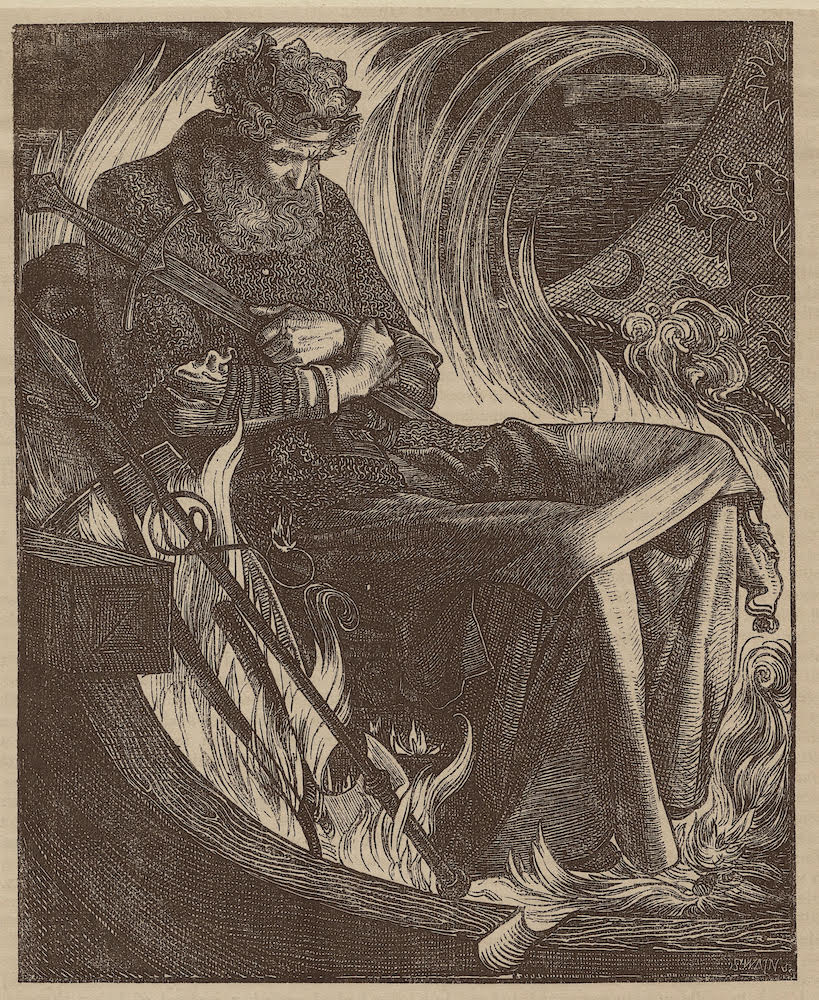

The Death of King Warwolf. 1862. Left: Brush and black ink on cream paper. 5 9/16 x 4 1/2 inches (14 x 11.4 cm) – image size. Collection of the Scottish National Gallery of Modern Art, accession no. D 3650. Image courtesy of the National Gallery of Scotland. Right: Wood engraving by Joseph Swain in black ink on off-white paper. 5 9/16 x 4 1/2 inches (14.2 x 11.6 cm) – image size. Private collection, image courtesy of the author. [Click on the images to enlarge them.]
Betty Elzea describers the finished drawing as showing the old king "seated, his body facing half to left, with his head bowed and his arms across his chest, holding his sword to his breast. The upper part of his body is covered with chain mail, the lower part with long robes. He is seated in the stern of a boat, surrounded by flames, with spears and a shield at his side. There are three differences between this drawing and the print: the plain ribbed sails in the drawing were altered to ones decorated with devices of sun and moon and a heraldic lion; the dark border of the King's robe in the drawing was removed in the print, and the monogram 'AFS' was added to the side of the boat in the print" (213).
This drawing was commissioned to illustrate the poem "The Death of King Warwolf, A Norse Legend" by Walter Thornbury which was published in Once a Week, Volume VII, on 30 August 1862 on page 266 (from which the earlier image on this page was originally scanned by George P. Landow). King Warwolf, who is near death, chooses not to die in his bed but, like a true Viking hero, in his ship, which is set on fire while he still lives.
The great King Warwolf waxing old,
And feeling that death was nigh at hand,
Resolved to die as a hero should —
Not pent in a bed, and then hid in the sand;
So he clad him brave in his golden mail,
And took his axe and his massiest shield.
And his spear, and his bow, and his two-edged sword —
That no one else but himself could wield.
And he bade them drag his galley forth,
And load it with trunks of the driest pine,
And store it with oak-butts knotty and ringed,
And pile it with fir-cones line on line.
So they set the gold-cloth sails all fair.
And they tied the well-worn helm due north.
And they bore him down on their brazen shields
To the barque that was destined to bear him forth.
Sitting erect on his fir-tree throne,
In his royal robe and glittering crown,
As the fateful galley bore away
Slowly out of sight of the town,
Singing to Odin hymns of praise,
Cheerily, though with a failing breath,
He went in splendour and bold of heart,
In a kingly way to meet King Death.
They watched till they saw the ship go down
Below the long grey line of sea;
And then there arose a great red glare,
That seemed to crimson fitfully
The whole broad heaven, and melt the waves
Into one caldron of blood-red light,
And soon all suddenly there fell
A pitchy gloom, and then came NIGHT.
The illustration is a very effective portrayal of the incident described in the poem. It was later reprinted in Walter Thornbury's Historical and Legendary Ballads and Songs in 1876.
Bibliography
The Death of King Warwolf. National Gallery of Scotland. Web. 22 August 2025.
Elzea, Betty. Frederick Sandys 1829-1904. A Catalogue Raisonné. Woodbridge, Suffolk: The Antique Collectors' Club Ltd., 2001, cat. 2.B.45, 213-14.
Reid, Forrest. Illustrators of the Sixties. London: Faber & Gwyer Limited, 1928.
Thornbury, Walter. Historical and Legendary Ballads and Songs. London: Chatto and Windus, 1876. 14.
Created 13 November 2009
Last modified 22 August 2025